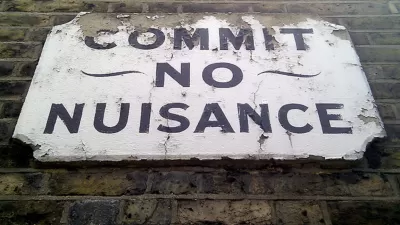The history of how homeowners came to wield expansive power over the development of entire neighborhoods and cities is complex and can't be traced to any one policy or market trend.

Emily Badger explores the rise of the "Not In My Backyard" (NIMBY) movement to power—and its ability to expand its political influence beyond the backyard to the entire neighborhood.
The causes of NIMBY campaigns are familiar. "In Seattle, the neighbors don’t want apartments for formerly homeless seniors nearby," writes Badger. "In Los Angeles, they don’t want more high-rises. In San Jose, Calif., they don’t want tiny homes. In Phoenix, they don’t want design that’s not midcentury modern."
Common among these opposition campaigns is a conviction "that owning a parcel of land gives them a right to shape the world beyond its boundaries," according to Badger, who traces the roots of the idea that the influence of property owners should reach well beyond the property line.
Badger references nuisance laws, schools, race, and advent of citywide zoning in this examination of the exclusionary tendencies of NIMBY campaigns. The article's conclusion is particularly powerful, suggesting how deep a cultural shift will be necessary to disentangle the power of obstructionists from the future needs of cities and communities: "We want people to be invested in their neighborhoods, but not to the exclusion of anyone else who might live there, too. We want to empower neighbors to fight a trash dump, but not to halt every housing project the region needs."
FULL STORY: How ‘Not in My Backyard’ Became ‘Not in My Neighborhood’

Trump Administration Could Effectively End Housing Voucher Program
Federal officials are eyeing major cuts to the Section 8 program that helps millions of low-income households pay rent.

Planetizen Federal Action Tracker
A weekly monitor of how Trump’s orders and actions are impacting planners and planning in America.

Ken Jennings Launches Transit Web Series
The Jeopardy champ wants you to ride public transit.

Crime Continues to Drop on Philly, San Francisco Transit Systems
SEPTA and BART both saw significant declines in violent crime in the first quarter of 2025.

How South LA Green Spaces Power Community Health and Hope
Green spaces like South L.A. Wetlands Park are helping South Los Angeles residents promote healthy lifestyles, build community, and advocate for improvements that reflect local needs in historically underserved neighborhoods.

Sacramento Plans ‘Quick-Build’ Road Safety Projects
The city wants to accelerate small-scale safety improvements that use low-cost equipment to make an impact at dangerous intersections.
Urban Design for Planners 1: Software Tools
This six-course series explores essential urban design concepts using open source software and equips planners with the tools they need to participate fully in the urban design process.
Planning for Universal Design
Learn the tools for implementing Universal Design in planning regulations.
Heyer Gruel & Associates PA
Ada County Highway District
Institute for Housing and Urban Development Studies (IHS)
City of Grandview
Harvard GSD Executive Education
Toledo-Lucas County Plan Commissions
Salt Lake City
NYU Wagner Graduate School of Public Service





























